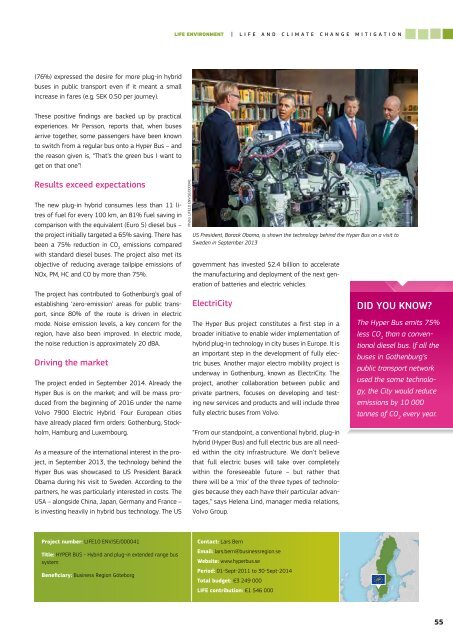You also want an ePaper? Increase the reach of your titles
YUMPU automatically turns print PDFs into web optimized ePapers that Google loves.
LIFE ENVIRONMENT |LIFE and Climate CHANGE mitigation(76%) expressed the desire for more plug-in hybridbuses in public transport even if it meant a smallincrease in fares (e.g. SEK 0.50 per journey).These positive findings are backed up by practicalexperiences. Mr Persson, reports that, when busesarrive together, some passengers have been knownto switch from a regular bus onto a Hyper Bus – andthe reason given is, “That’s the green bus I want toget on that one”!Results exceed expectationsThe new plug-in hybrid consumes less than 11 litresof fuel for every 100 km, an 81% fuel saving incomparison with the equivalent (Euro 5) diesel bus –the project initially targeted a 65% saving. There hasbeen a 75% reduction in CO 2emissions comparedwith standard diesel buses. The project also met itsobjective of reducing average tailpipe emissions ofNOx, PM, HC and CO by more than 75%.The project has contributed to Gothenburg’s goal ofestablishing ‘zero-emission’ areas for public transport,since 80% of the route is driven in electricmode. Noise emission levels, a key concern for theregion, have also been improved. In electric mode,the noise reduction is approximately 20 dBA.Driving the marketThe project ended in September 2014. Already theHyper Bus is on the market; and will be mass producedfrom the beginning of 2016 under the nameVolvo 7900 Electric Hybrid. Four European citieshave already placed firm orders: Gothenburg, Stockholm,Hamburg and Luxembourg.As a measure of the international interest in the project,in September 2013, the technology behind theHyper Bus was showcased to US President BarackObama during his visit to Sweden. According to thepartners, he was particularly interested in costs. TheUSA – alongside China, Japan, Germany and France –is investing heavily in hybrid bus technology. The USPhoto: LIFE10 ENV/SE/000041US President, Barack Obama, is shown the technology behind the Hyper Bus on a visit toSweden in September 2013government has invested $2.4 billion to acceleratethe manufacturing and deployment of the next generationof batteries and electric vehicles.ElectriCityThe Hyper Bus project constitutes a first step in abroader initiative to enable wider implementation ofhybrid plug-in technology in city buses in Europe. It isan important step in the development of fully electricbuses. Another major electro mobility project isunderway in Gothenburg, known as ElectriCity. Theproject, another collaboration between public andprivate partners, focuses on developing and testingnew services and products and will include threefully electric buses from Volvo.“From our standpoint, a conventional hybrid, plug-inhybrid (Hyper Bus) and full electric bus are all neededwithin the city infrastructure. We don’t believethat full electric buses will take over completelywithin the foreseeable future – but rather thatthere will be a ‘mix’ of the three types of technologiesbecause they each have their particular advantages,”says Helena Lind, manager media relations,Volvo Group.Did you know?The Hyper Bus emits 75%less CO 2than a conventionaldiesel bus. If all thebuses in Gothenburg’spublic transport networkused the same technology,the City would reduceemissions by 10 000tonnes of CO 2every year.Project number: LIFE10 ENV/SE/000041Title: HYPER BUS - Hybrid and plug-in extended range bussystemBeneficiary: Business Region GöteborgContact: Lars BernEmail: lars.bern@businessregion.seWebsite: www.hyperbus.sePeriod: 01-Sept-2011 to 30-Sept-2014Total budget: €3 249 000LIFE contribution: €1 546 00055


